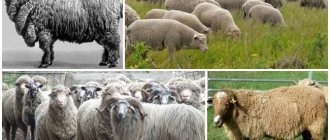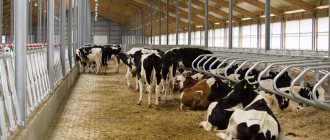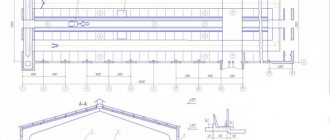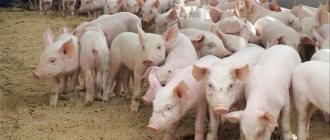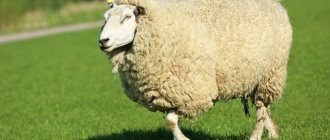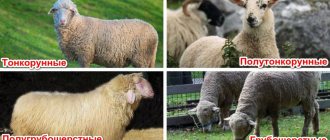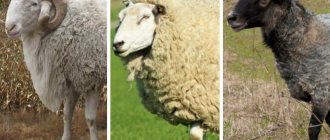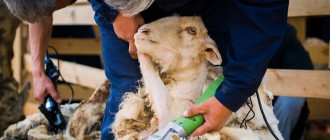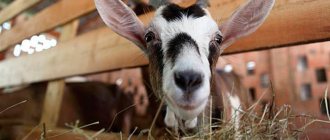Features and benefits of keeping sheep in a pen
Modern sheep breeding technology involves the use of several specific solutions at once. Animals can be kept freely, in special enclosures or exclusively in closed conditions. But, despite all sorts of differences, their main common feature can be called the corral, which becomes the center for keeping animals.
This combination allows you to create several types of sheep care systems on your farm:
- stable - sheep and rams are kept all year round in a closed area with an equipped walking yard;
- stall-pasture - animals are kept in a pen in the winter, and in the summer they are released onto artificial or natural pastures;
- pasture-stall - animals are kept in an open area all year, and only sick individuals or a woman in labor with a lamb are moved to a covered pen.
Important! The type of pen for rams and sheep is chosen according to the climatic and natural conditions of the growing region. Stall farming is the best option for cold zones with poor feed supplies, pasture-stall farming can be called the best option for areas with a mild climate and short winters, stall-pasture farming is optimal for agricultural regions with a moderately cold climate.
- Thanks to a good paddock, even in a mini-farm you can achieve:
- improving the general microclimate among animals;
- protection of sheep and rams from all kinds of infections and predatory animals;
- healthy maintenance regime;
- increased yield of meat, dairy products and wool;
- reducing the overall cost of keeping animals.
Construction Materials
To build a pen, you need wooden posts, poles and boards, as well as chain-link mesh or metal-plastic for fencing.
The best type of wood for wooden pen parts is pine, which is resistant to rain and wind. It is also necessary to provide fastenings for fences and gates.
It is imperative to organize a canopy in the pen to shelter the animals from bad weather or the hot sun.
So, you will need:
- wooden poles and pegs;
- boards;
- fasteners (screws and nails);
- gate hinges;
- Rabitz;
- slate or tiles for the shed roof;
- sand and cement. These materials are needed for fixing support posts and in cases where the farmer plans to concrete the surface of the paddock.
More on the topic: Productivity indicators of the Kuibyshev breed of sheep
What is the design, requirements
The structure is an insulated and covered barn, within the walls of which animals spend the night and take shelter from adverse weather conditions, as well as nearby infrastructure. At its core, a pen is a complex of various structures that provide animals with the correct mode of life.
This is achieved by distributing the living space of sheep into a stall, a place for pasture, as well as an area for eating and drinking water, with or without a canopy. This allows each artiodactyl to be given the necessary space for walking, as well as regular feeding.
That is why quite serious requirements and conditions are put forward for such a structure:
- within the walls of the barn, the daily air temperature should not drop below +12°C, cold in the building is unacceptable;
- sheep must be exposed to moderate humidity, so the walls of the shed are made only from vapor-proof materials or the design includes an air ventilation system;
- Regardless of the period of the year, there should always be light in the sheepfold;
- every adult animal should be provided with as much free space as possible;
- for construction, only warm material is chosen, with a low thermal conductivity coefficient;
- if more than one breed is raised on the farm, the entire sheepfold area should be divided into several compartments for each of them.
Site selection
Whether you decide to buy a ready-made farm in the countryside or build new paddocks, the availability of pasture will play an important role. They need to be equipped with fences to protect the animals from predators. You can build fences out of wire and use a weak electric current. Sheep are insensitive to its effects because they are protected by thick wool, and predators can be scared away.
Without the possibility of free grazing, keeping sheep is unprofitable.
In order not to deplete the area, you will need to make internal fences and take care of rotation of pastures. The fact is that sheep graze thoroughly, destroying plants at the roots. If you have limited grazing area, then use mobile fencing: you will direct the sheep to a certain area. In other areas, new grasses will have time to grow.
In order for an animal to have enough green food in the summer, it must spend at least 14 hours on the pasture. During this time, a ram will eat 16 kg of grass, a suckling queen - 15, a lamb - 2. Consider the factor when choosing a pasture: the best option would be a meadow with fine grass. But wet areas with buttercups, sedge and horsetail, as well as forest pastures will be unsuitable.
Experienced sheep breeders also give advice on regions. In the Astrakhan region, Kalmykia, Stavropol region and the North Caucasus, the opportunity to open a new business is limited due to competition. It is easier to cope with the tasks in the central regions, but it will not be possible to raise livestock on grass from pastures without additional feed. But grain prices will be more affordable, so there are still prospects.
If you are hatching the idea of starting a sheep farming business on a grand scale, purchase purebred animals. Productivity is not satisfactory, and you will know about possible problems in advance. Among the breeds, breeders distinguish the following:
- Romanovskaya is distinguished by multiple births, reaching 300%. The meat is in demand in the central regions, but residents of the Caucasus consider it tasteless. The breed also has a drawback: it is kept mainly for its wool, which is difficult to sell. Experienced sheep breeders continue to argue about the benefits of such breeding.
- Texel can be difficult to find in the Russian Federation. But the productivity of the breed makes up for the disadvantage, because the meat of the animals has a pleasant taste and the absence of a specific smell.
- Tsvatrbles is a meat and dairy breed. Productivity is 235%, and the queens lamb easily. Thanks to their thick fur, animals can withstand cold, dampness, and wind.
- Dorper is suitable for meat breeding, as Canadian farm owners have proven. But in the Russian Federation it can be difficult to find lambs, and the price is high. Despite the disadvantages, the advantages of the breed outweigh. The animals require less feed than ordinary sheep, which is ensured by their metabolic characteristics. As a result, they have enough grass even in infertile pastures.
- The Gissar breed is suitable for breeding for meat. Although its representatives will not please you with fertility, the growth rate of lambs is 600 g per day. Please note in advance that there are several directions in it: meat, meat-grease and lard.
Read more: Types of cow diseases treatment plans review
Once you have decided on a breed, think about the age of the animals. If you do not have experience, it is not worth taking lambs. It is new farmers who complain that their pets die for no apparent reason. After all, sheep are different from other animals: for example, sick pigs change their behavior. But the sheep, as long as it is able to stand on its feet, grazes with the herd. Without a trained eye, you will not notice the loss of body weight, which is “masked” by the coat, or the limping.
Gaining experience by purchasing young animals is not a good idea. Therefore, refuse to purchase lambs and opt for females 3-5 years old. The beginner’s task is not to find a high-breed animal, but to buy healthy sheep. They must have endurance, because during the first 2 years you will inevitably make mistakes in care, feeding, and breeding.
DIY construction process
Any building on a site is a complex structure that involves several technical solutions at once, so the construction process often involves several successive stages, including preparing the site and materials for the future building, and only then erecting the frame elements of the building.
Check out: sheep farming in countries around the world.
Site selection, area calculation, drawings
To build a sheepfold correctly, the construction of the structure should begin with careful preparatory work. First of all, you need to choose a good site for this that meets all the technical requirements for the construction of permanent buildings.
In addition, such a place must be convenient for walking, otherwise the livestock will get sick and its productivity will decrease significantly.
The ideal place for this should be on a slight hill or plain, with dense and moderately moist soil. The general territory of the complex should be located in open areas, away from tall vegetation and other buildings.
Important! To provide the livestock with better conditions, it is recommended to increase the minimum size of the pen by at least 1.5–2 times. This will help avoid space shortages in the event of a sharp increase in the birth rate in the herd.
Animals should receive maximum light and fresh air; only in such conditions will they develop normally and produce high-quality products. It is best if the selected area is near a small source of water, which will serve as an ideal place for collecting drinking moisture.
- It is highly not recommended to build sheepfolds and keep artiodactyls on:
- wetlands;
- clayey or excessively viscous soils;
- areas with rock;
- excessively hilly or lowland areas;
- sites near highways or industrial enterprises;
- territories adjacent to the cattle burial ground.
Before arranging the future farm, you also need to create a detailed project or at least a schematic drawing. During this period, it is also necessary to carry out a detailed calculation of the space required for the pen.
According to existing veterinary standards, when raising a flock of sheep and lambs, at least 1 m² of space per individual is required, for rams this figure increases to 1.7 m². By counting the number of individuals in the future farm and multiplying the numbers by these indicators, you can accurately obtain the minimum size of the area.
We recommend that you familiarize yourself with the difference between a ram and a sheep, a lamb and a lamb, and sheep records.
The height of the building must also be strictly approached: it must be at least 2 m, and it must ensure normal human access to care for the animals.
When arranging, you should also decide on the height of the protective fence; it should be in the range of 1.2–1.5 m, but if there is a herd of more than 30–50 animals, it is better to increase the height to 2 m. Without this, under the influence of the herd instinct, the cattle will try to jump over the fence.
Video: Sheep Summer Camp
Tools and materials
| To properly build a sheepfold you will need the following set of tools: | Materials you will need: |
| drill or screwdriver | cement grade no less than M400 |
| jigsaw | river sand, purified |
| plane | construction crushed stone |
| hand saw | mounting rail |
| chisel | construction board, polished |
| roulette | wooden beam 50×100 mm |
| wooden pegs and marking rope | wooden beam 100×100 mm |
| hammer | OSB board 3 |
| axe | timber, brick or cinder block (for building walls) |
| bayonet and scoop shovel | siding, clapboard or any other cladding material |
| pliers | roofing material to choose from (slate, roofing felt, metal tiles, etc.) |
| rope | fastening elements (nails, screws, etc.) |
| set of screwdrivers of different sizes |
Clearing the area, preparatory work
Once you have managed to choose the ideal place for the pen, you need to carefully prepare the area for the construction of an agricultural building. First of all, the site should be cleared of any vegetation, and especially of bushes and young trees.
To do this, the entire above-ground mass should be mowed with a walk-behind tractor, trimmer or hand scythe. At the same time, if possible, the soil surface should be cleaned of any contaminants, including stones.
Did you know? Domestic sheep are considered one of the oldest animals used by humans for economic purposes. They were domesticated 8 thousand years ago in the territory of Ancient Syria, Turkey and Mesopotamia.
The next stage of preparatory work can be called leveling the site. At this stage, you need to manually or using all kinds of technical means to level the soil to one level.
If excess soil appears, it is recommended to distribute it evenly throughout the territory of the future paddock. Thus, this will help create a slight hill, which will best protect the site from spring flooding.
Marking
The first technically difficult stage of building a pen can be called marking the territory. During the process, using wooden pegs and a marking rope, a schematic layout of the main structure is created on the site, as well as additional ones: a walking yard, a canopy, etc.
At the same time, it is necessary to mark the location of the foundation, including its required thickness. After all the manipulations along the boundaries of the territory, high pegs should be installed, in place of which a protective fence should be installed in the future.
Foundation
The formwork is installed along the previously marked pegs. To do this, small vertical supports are created from the mounting rail, which are tied around the perimeter with boards, so you should get a complete structure about 30 cm high.
A depression of at least 60 cm in the soil is dug along the entire length of the formwork. After this, the depression, up to the upper boundary of the formwork, must be filled with concrete mortar. Next, you should wait at least 1 week for the liquid mixture to harden, after which the formwork can be removed and the construction process can continue.
Frame
The top of the concrete foundation should be covered with insulation, on top of which a frame of 100×100 mm wooden beams is installed. First, the timber is laid horizontally along the perimeter of the foundation, after which vertical posts made of the same material must be installed in each corner. The racks are secured at the top with horizontal ties.
Check out
How many years do domestic rams and sheep live? After this, for reliability, each wall is reinforced with additional racks and bevels from the same 100x100 mm bars.
The bevels are mounted with one edge at the top of the wall, and the other near the foundation, on the opposite side.
In this case, the installation should be provided in such a way that doors and windows can be installed on the required side.
Next, you should equip the roof frame; make it single-pitch or gable, depending on the farmer’s requirements in a given situation.
Walls
The created frame is filled with any of the available materials, but most often wooden beams are used for this. It is fixed between adjacent posts, which allows you to build a reliable wall. From the outside, such walls are sheathed with any of the available façade materials.
To reduce the cost, the frame is sheathed with moisture-resistant wood slabs or sanded boards on the outside and inside, or a wooden pallet is used for this. However, in this case, the cavities between the walls should be filled with insulation (mineral wool, small wood shavings, etc.), and the outer walls must be painted with deep-penetrating paint.
Roof
Before covering the roof, this part of the building, according to the general technology for the construction of residential and non-residential structures, must be strengthened. Along the entire perimeter of the frame, horizontal crossbars from a mounting rail are attached, on top of which OSB boards should be screwed.
If possible, the slabs are covered with any waterproofing material (special films or roofing felt), only after that the roof is sheathed with roofing material. To do this, choose any of the existing options, with slate being considered the cheapest.
Important! The roof is secured with an overlap of sheets and other components of at least 15 cm, otherwise such a roof will definitely leak, and its repair will require additional investments.
Floor
Often the floor in the pen is made of concrete, at least 20 cm thick. Other materials are unsuitable for this; they do not allow creating a holistic and at the same time reliable floor. Fill the floor with concrete mortar throughout the entire inside of the pen, while achieving a slight slope of about 4°. A small gutter should be installed at the lowest point, through which animal excretions or other liquids can be removed in the future.
Doors, windows
Doors are one of the main elements of the pen; they are made large, at least 2 m wide. This is necessary so that 2 adult animals can be driven inside without hindrance. Double-leaf gates made of metal, wood or plastic are best suited for this.
Windows are installed at a height of at least 140 cm from the base, they are made small, with a tilt-and-turn opening mechanism. This will help create an adjustable ventilation system not only for the entire structure, but also for the individual cage of each individual. The optimal window dimensions are 160x110 cm, but depending on the conditions, they can be adjusted.
Be careful
It is necessary to trim the wool evenly, along the entire length, but do not cut the sheep. Sharp scissors are required for an even cut. When cutting, you will have to straighten them with a whetstone from time to time. You will get an even cut if the area of the captured wool and the scissors do not close completely.
The part that remains open must also be folded towards the middle and placed on top of the first folded parts. The finished layer of wool must be rolled up, the ends facing each other, moving from the head and tail. Tie the finished roller with twine and you can put it in bags.
The most profitable and common sheep on the farm are considered to be the Romanovskaya meat fur coat breed. They are not only unpretentious in food and maintenance, but also prolific. The lifespan of sheep is 10 – 15 years. But keeping them after 5 years of life is not advisable. Therefore, when choosing a sheep, you need to pay attention not only to its physique, but also to its age.
Hi all! Today I want to talk about such a business sector as livestock farming. Beginners are wary of it, but an analysis of the sphere shows its promise. Sheep farming as a business for a novice farmer will delight you with its simplicity, and its products will be in demand.
Arrangement
Before putting the pen into operation, it will need to be well equipped; this will make keeping sheep as comfortable as possible for the animals themselves, as well as for humans. To do this, all kinds of additional buildings and other elements, such as a feeding trough, stalls and nurseries, are placed in the structure.
Feeders, drinkers, stalls and nurseries
For a comfortable stay for animals, the common area should be divided into several parts, with separate housing for lambs, sheep and young animals. For adult individuals, common or individual stalls with small partitions are erected.
Read how to make feeders, drinkers, and nurseries for sheep yourself.
They are arranged so that each individual has plenty of free space, so their width should be at least 70 cm. Nurseries are created in the form of small elongated troughs, up to 50 cm wide.
Parameters of common feeders:
| Characteristics of the animal | Minimum dimensions for 1 individual, cm (H×D×W) |
| Lambs up to 45 days old | 20×15×15 |
| Young animals up to 1 year | 30×30×30 |
| Females | 40×30×40 |
| Males | 40×30×50 |
Each pen is equipped with individual or common feeders, divided into containers for bulk and wet food, as well as for hay. For bulk and wet feed, deep elongated troughs are used, for hay - a special mash-shaped feeder with through holes.
In addition, a drinking bowl should be installed near the feeders. It can be any utensil made of safe metals or plastic; each such container must have a volume of at least 6–10 liters. The floor in the pen should be covered with a bedding of hay or straw. In winter, its layer should be at least 20 cm; in the warm season, the thickness can be reduced to 10 cm.
Walking pen
The exit from the pen must be directed to the common walking area. It is an open area with a level surface. Since the wool of sheep and rams is quite dense and thick, animals can be released for walks throughout the year, with the exception of short periods of minimal winter temperatures. The size of the walking yard should be maximum, with a space of at least 2 m² provided for one adult animal.
We recommend reading how to properly herd sheep.
Canopy
If the livestock numbers more than 50 animals, it is necessary to make a small protective canopy on the territory of the walking yard, providing each animal with an area of at least 0.8 m². To do this, 4 stands made of wood or metal with a diameter of at least 10 cm are buried in the soil.
In the upper part they are tied with horizontal bars, after which a lean-to or gable roof is installed. In the case of excessively large livestock, the canopy is also made larger, in which case the number of supporting posts is increased. They are dug in at a distance of no more than 4 m.
How to start a sheep farming business
First, draw up a business plan for sheep farming: a ready-made version can be found on the Internet, but it will need to be adapted to your situation. Also decide on the format of the activity. In addition to a personal subsidiary plot (LPH), you can acquire a farm. What is the difference between these concepts?
When running a personal household, activities are aimed at meeting the needs of the family. If you prefer to become a farmer, you will have to register as an entrepreneur. The difference doesn't stop there:
- The farm owner is required to submit a report to the tax authorities. If you breed animals for personal needs, you will not need to submit documents to the fiscal services.
- The form of private household plots provides for voluntary participation in pension funds. The farm owner who has registered a state of emergency must make contributions for his employees.
- For private household plots there are restrictions on the area of land. If you need pasture larger than 2.5 hectares, you will have to farm.
- Owners of private household plots cannot count on grants available when registering a state of emergency.
If you run a private household, then the activity is not considered entrepreneurial. At the same time, you have the right to sell surplus, so it is advisable for beginners to choose this form. When you gain experience and expand your business, you will register a farm. This is necessary when the activity is carried out clearly for commercial purposes.
Fence installation instructions
Once the pen is completely constructed, you can begin installing the protective fence. One side of it should border the walls of the covered pen and fit snugly against it, the other should be installed on the edge of the walking yard.
According to the previously applied markings, the supporting racks should be installed. They can be metal pipes or wooden beams, dug to a depth of at least 40 cm, with a distance of 4–6 m. This is done so that the stand must be in place of each corner of the site.
Next, horizontal crossbars should be attached to the support at a distance of 15–20 cm from the ground and the top of the racks. At the end of the procedure, you should get a stable frame that will withstand any load. It should be sheathed; to do this, boards, metal mesh, etc. must be secured to the horizontal crossbars. This is done in such a way that the outer sheathing turns into an integral structure.
Recruitment of personnel for farming
Recruiting staff requires planning, especially in the early stages when you have limited funds. For a herd of 200-300 sheep, several employees will be needed:
- shepherd;
- milkmaid;
- employee to feed animals and maintain cleanliness.
To save money, duties can be combined. You will also have to contact a veterinarian and a shearer, but if there are a large number of heads, they are hired on a permanent basis.
Choose a shepherd carefully, because you are not going to hire an ordinary shepherd. Find a hereditary specialist: he performs the functions of a veterinarian, shearer, and livestock specialist. On what terms will he agree? When hiring, many people ask to transfer 50 heads into their possession; they negotiate a percentage of the income, bonuses for the safety of the offspring, etc.
The problem arises with the staff for feeding the sheep and cleaning. Since the work is dirty, candidates are often marginalized. If possible, pay more, but hire decent, ideally light-drinking people.
Additional devices
To provide sheep with the best microclimate, additional technical devices in the room are indispensable. The most important of them are the heating system and ventilation. The ventilation system is installed at a height of about 35 cm above the floor or under the ceiling; it can be natural or artificial. Wide-channel installations with a diameter of outlet pipes of about 50 cm are best suited for this.
Fresh air through the window 1 enters through the air channel 2 parallel to the ceiling covering 3 beyond the placement area in the stall 4 . Then the cold fresh air entering the room falls vertically down into the side channel 5 of the manure storage 6 . Here it comes into contact with manure 7 , displaces and removes harmful compounds from it, and as a result of the interaction, the warm air mixture already heated in this way is removed 6 8 vertically upward. In this case, the draft is created by opening and closing the damper 9 of the air channel 2 and the exhaust windows 10 made in the lantern 11 .
Absolutely any heating system can be provided, the main thing is that in the harshest winters at a load of no more than 80% it ensures an internal temperature of at least +16°C. The most profitable and simplest for this purpose can be called a complex of electrical installations for hot air injection. It allows you to instantly warm up the room and, if necessary, cool it just as quickly.
Did you know? The Dolan breed is considered to be the most expensive sheep in the world. The total number of these animals is about 1000 individuals, and the price for one animal reaches $2–2.5 million.
A sheepfold is the first thing a livestock owner should think about before purchasing animals. The construction of this structure should be approached responsibly, since any mistakes can lead not only to immediate wear of the structures, but also endanger the health of the sheep. This can negatively impact the profitability of livestock production and deteriorate the health of livestock.
For what purposes can you engage in sheep farming?
Despite the advantages, sheep farming as a business in Russia cannot be called prosperous. The problem is that the products of domestic farms cannot even meet market requirements, not to mention world standards. But budding businessmen will be helped by examples of successful Western farms.
Traditionally, wool production dominated in the Russian Federation. But prices for raw materials are rising slowly, which does not allow covering costs. A private farm has little chance of concluding a contract with a wool processing enterprise, so problems arise with sales.
To avoid them, focus on the production of lamb and young lamb. It is also profitable to sell rams and pregnant queens for brood. Place your bet on meat breeds: North Caucasian or Texel. But they have disadvantages, because in winter they need to be kept in insulated rooms. You can avoid difficulties if you choose the Romanov breed: females are fertile, with each litter containing 3-5 lambs. You will also notice the following advantages:
- undemanding to feed;
- good immunity.
Unpretentious animals quickly adapt to climatic conditions, so there will be no problems with maintenance.
Sheep farm for 100 heads
The farm for 100 animals consists of buildings for various purposes and pastures. Sheep keeping is divided into 2 periods: stall and pasture. The first occurs during the cold season and lasts 150-180 days. The rest of the time the animals are kept on pastures.
The dry area chosen for the sheep farm must have a slope of at least 2-3 degrees. Shepherds, shed bases, premises for shearing sheep, preparing feed, temporary greenhouses and other buildings are erected on it. When drawing up a master plan for the site, the current SNiP and standards that determine the minimum required area for keeping 1 animal are taken into account. They are for canopy bases:
The area standards for greenhouses are:
The size of a sheepfold for 100 heads of livestock must be at least 360 sq.m.
You can read more about sheep breeding in our special article.
Video - Setting up a sheepfold
Receipt and sale of products
The main source of profit for a beginning sheep farmer will be the sale of meat products. Trade in cheese will also be added to this, but milk from these animals is not in demand.
Experts note that a restructuring of mentality is becoming an important task for pastoralists in the Russian Federation. Try to perceive your activity as a business from which you need to get maximum efficiency.
Meat is sold through markets: this is more profitable than selling it to resellers. If possible, enter into contracts with restaurants or supermarkets. True, problems arise in this area, since well-known establishments have already acquired suppliers. The latter would rather change the conditions than allow them to intercept the client.
In general, sales are possible in the following ways:
- slaughter and independent sale;
- wholesale shipment of live sheep;
- organizing your own slaughterhouse and producing semi-finished products.
You will acquire a slaughterhouse equipped according to the standards when the business gains momentum. But practice shows that the greater the scope, the easier the sale and the more profitable the price.
As for wool sales, sheep farming as a business in Russia is moving away from this direction. The classified product is the most valued, but it is difficult for private farm owners to cope with its production. Selling unprocessed wool is not profitable: you will spend more on hiring a shearer and transporting the goods.
Sheep cheese is in demand, but another problem arises here. According to reviews from sheep farmers, the only farm in the district is not able to satisfy consumer demands. As a result, the loss of the client occurs: to avoid such developments, farmers unite through forums. They coordinate the work, with each farm owner specializing in the production of a certain type of dairy product.
When selling lamb or sheep's cheese, the challenge is not to compete with the supermarkets: if you compete with the giants, you will lose. Your target audience does not consist of consumers of mass products, but of people who monitor their health and choose environmentally friendly and tasty food. By focusing on quality, you will find a consumer.
Providing feeding
The most important elements of a sheepfold are the feeder and waterers for the sheep. Such equipment is installed taking into account the number of herds. A sheep needs about 7-11 liters of water per day. To provide the animal with drink, drinking bowls are needed in the form of long troughs with a volume of at least 80-90 liters. A standard drinking trough has the following dimensions: length – 160-170 cm, width – 47-50 cm, depth – 45-47 cm.
The most important elements of a sheepfold are the feeder and waterers for sheep
Usually, sheep feeders are made with your own hands. They can be of different types, and caring owners also install several options for different types of feed: forbs, straw, hay, silage, salt additives.
The most common feeders are made from wooden elements, in the form of a playpen and from metal. The wooden feeder has a simple design. A tray (trough) is placed at the bottom to prevent scattering of hay. It is installed on legs with a height of about 40-45 cm. The width of the trough is 30-35 cm. Then slats are attached obliquely in increments of 8-12 cm. The height and length of such a feeder depend on the number of animals. For example, for 7-8 sheep the length is 2 m.
A sheepfold, even for a small herd, should have several compartments
The playpen-shaped feeder is also quite popular. Near her, the sheep are arranged in a circle. The structure itself is a metal mesh with large cells. A round tray is made at the bottom, which is raised above the ground by 45-50 cm. Feeders in the form of metal troughs are highly reliable.
Another option is a system with a slope. The design is good when feeding finely chopped grass or grain. The feeder is made in the form of a dispenser with an angle. As the animals eat the food, an additional portion arrives along the inclined plane. Concentrates and fortified feeds are used to feed lambs. To supply them, separate feed nurseries are installed, which are fenced off from the general premises.
Sheep are considered fairly unpretentious pets, preferring long stays in the open air. However, in winter and in bad weather they must be covered indoors. For this purpose, a sheepfold is being built, the construction of which can be done on your own.
Reproduction
The behavior of the flock needs to be monitored daily, but sheep are generally easy to raise. The point is that sheep can do their business whenever they please. As farmers said, a sheep could become pregnant even during the lactation period. There is a plus here, because because of this she can produce 3 or more lambs in a year. Puberty occurs at four to five months, but during this period it is not yet recommended to let the ram near the ram.
There is an opinion that sheep can only be bred when the female has gained 80% of the weight of an adult sheep, which is about forty kilograms. Mating occurs at this moment, the duration of which is two to five days. The female carries the lamb for 145 days and then gives birth on her own without human assistance.
Three days before the expected birth, the sheep should have the wool between its legs and around the udder trimmed. Before giving birth, the female will begin to get up and lie down frequently and bleat loudly. There is only enough milk for three lambs, so if a ewe has given birth to more than three babies, they should be switched to artificial feeding.
Pedigree sheep farming as a business
Beginners are wondering whether it is possible to make money by breeding pedigree sheep. After all, they ask for several hundred dollars for a breeding sample! But in practice, the main source of profit remains the sale of meat. The shades of taste associated with the breed are unlikely to be distinguished by the consumer. The main criterion remains age: the difference between the meat of a 3-year-old and 1-year-old sheep is immediately noticeable.
For this reason, beginners should not spend money on purchasing expensive animals. You are unlikely to be able to purchase a high-breed sheep; moreover, due to a lack of knowledge, you will make mistakes in keeping and breeding. It will take you 1-2 years to gain experience, so buying a couple of sheep for $500 each is not a good idea. Animals can die simply because you didn’t give the anthelmintic on time!
In addition, starting with good breeding material is expensive. The purchase of livestock and feed will require investments that are unaffordable at the initial stage. And the status of a breeding reproducer can only be obtained with 5 years of experience, so just look for healthy animals that are inexpensive and inexpensive to maintain.
Using pedigree cattle for meat production is not always profitable; Farmers usually come to a pure breed within 5-6 years, during which time they work with more budget-friendly options.
Dependence of paddock area on livestock
These animals can be bred not only in large areas, but also in limited areas. The size of the pen depends entirely on the sheep population that is planned to be kept in it.
The following combination is considered optimal: for one ewe - at least three square meters, for one ram - five and approximately 2 square meters for each head of young stock. However, not everyone can create such conditions, so the main requirement is that the area per animal be at least 0.8 square meters.
Let's go for a walk
There should always be a free range for livestock near the sheepfold, where animals can spend time in the summer. There is a canopy for protection from bad weather. The place for walking must be flat, hard, and grass must grow abundantly on it. Such an open enclosure is surrounded by a fence. It’s easy to calculate the walking area: one sheep requires a space of 1.7-5 square meters. m., ewe – 1.2-3 sq. m., lamb - 0.8-2 sq. m.
Laying the foundation
From the many types of foundations, you should choose the option that is most suitable in terms of time and budget. The pouring hardens for at least a month, construction must begin taking into account all the little details, so that the sheep will sit near warm feeders before frost.
Consider a pile foundation. It is considered the most reliable; the technology does not require digging huge holes or making formwork. In addition, it is suitable for any type of soil. Wooden piles are driven into the ground using special equipment, and for drilled wells they are drilled with hand tools. A layer of waterproofing is laid on the fundamental basis for strength and reliability. Afterwards they make a wooden frame.

